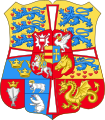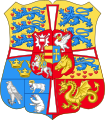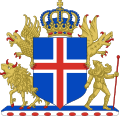Coat of arms of Iceland facts for kids
Quick facts for kids Coat of arms of Iceland |
|
|---|---|
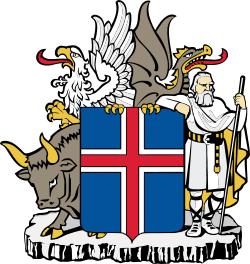 |
|
| Versions | |
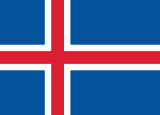
The banner of arms, which serves as national flag
|
|
| Armiger | Iceland |
| Adopted | 1 July 1944 |
| Coat of arms of the president of Iceland | |
|---|---|
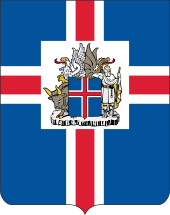 |
|
| Armiger | President of Iceland |
| Adopted | 1944 |
The coat of arms of Iceland is a special symbol for the country. It shows a blue shield with a red cross that has silver edges. This design looks a lot like the flag of Iceland.
What makes Iceland's coat of arms unique is that it's the only one in the world with four "supporters." These are like guardians that hold up the shield. They are the four protectors of Iceland, known as landvættir (pronounced: LAND-vat-teer). These protectors stand on a block of columnar basalt, which is a type of rock that looks like tall columns.
The four protectors are:
- The bull (Griðungur) looks after northwestern Iceland.
- The eagle or griffin (Gammur) protects northeastern Iceland.
- The dragon (Dreki) guards the southeastern part.
- The rock-giant (Bergrisi) is the protector of southwestern Iceland.
People in Iceland used to respect these creatures a lot. During the time of the Vikings, there was even a law. It said that no ship should have scary symbols, like dragon heads, on its front when it came near Iceland. This was to make sure the protectors were not upset!
You can also see the landvættir on the front of Icelandic króna coins. On the back of the coins, you'll find animals from the ocean, like fish, crabs, and dolphins. The President of Iceland uses a special Icelandic flag that has a "swallowtail" shape and features the coat of arms. The National Police and some other government groups also use a white flag with the coat of arms on it.
What does the coat of arms look like?
The government of Iceland has a clear description of its coat of arms:
The shield is sky-blue. It has a silver cross, and inside that silver cross is a bright red cross. The arms of the cross reach all the way to the edges of the shield. The silver cross is 2/9 of the shield's width, and the red cross is half as wide, at 1/9 of the shield's width. The top parts of the shield are square, and the bottom parts are the same width but a bit longer.
The four guardian spirits of Iceland hold up the shield. They are described in an old book called Heimskringla, written in the 13th century.
- A bull is on the right side of the shield.
- A giant is on the left.
- A vulture (or eagle) is on the right, above the bull.
- A dragon is on the left, above the giant.
The whole shield rests on a base made of columnar basalt rock.
How has the coat of arms changed over time?
Iceland has had different coats of arms throughout its history:
- The very first one might have been a shield with six blue stripes and six silver stripes. This could have represented the 12 local assemblies (called þing) of the Icelandic Commonwealth.
- Around 1258, a new coat of arms was given to Earl Gissur Þorvaldsson by the King of Norway. It looked similar to the King's own coat of arms, but with different colors and the blue and silver stripes added.
- Around the year 1500, the coat of arms changed to show a crowned stockfish on a red shield. A stockfish is a dried codfish. This symbol was known as Þorskmerkið (the "cod markings").
- On October 3, 1903, the coat of arms became a white falcon on a blue shield. This was used until February 12, 1919, when the first version with the landvættir became official. At this time, Iceland was a kingdom under the rule of Denmark.
- When Iceland became a republic (an independent country) on June 17, 1944, the coat of arms was updated. The Danish crown was removed, and the design of the landvættir was made official.
-
The coat of arms of Denmark from 1819 to 1903. Iceland is shown by the silver stockfish in the bottom left. Before this, Iceland was part of the Norwegian kingdom, so it used the coat of arms of Norway.
-
The coat of arms of King Christian X of Iceland (1918 to 1944) and Denmark (1903 to 1947). Iceland is shown by the silver falcon in the bottom left. The falcon was removed from the Danish arms in 1948.
-
The coat of arms of the Kingdom of Iceland from 1919 to 1944.
See also
 In Spanish: Escudo de Islandia para niños
In Spanish: Escudo de Islandia para niños
- Flag of Iceland
- Icelandic heraldry
- Flag of Denmark




